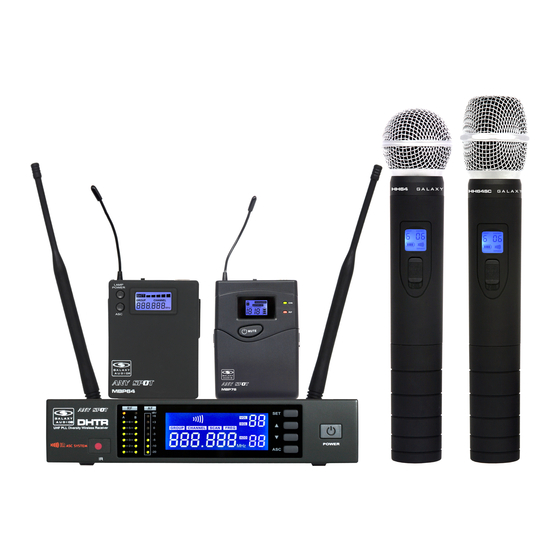Galaxy Audio HH64 사용자 설명서 - 페이지 2
{카테고리_이름} Galaxy Audio HH64에 대한 사용자 설명서을 온라인으로 검색하거나 PDF를 다운로드하세요. Galaxy Audio HH64 12 페이지. Galaxy audio dht wireless microphone system
Galaxy Audio HH64에 대해서도 마찬가지입니다: 사용자 설명서 (16 페이지)

System Components.........................................1
DHT Receiver Features.....................................2
HH76 Handheld Transmitter...............................3
MBP76 Body Pack Transmitter...........................4
System Setup.....................................................5
Setting Up Multiple Receivers.............................6
Rack-Mounting the Receivers............................7
Troubleshooting..............................................8
Specifications....................................................9
Thank you for choosing the Galaxy Audio DHT Wireless
Microphone System. You have joined hundreds of thousands of
other satisfied Galaxy customers. Since 1977 Galaxy Audio's
professional experience in design and manufacturing ensure
our products quality, performance and reliability.
For the most up-to-date manual and information
Frequency Band
Most countries closely regulate the radio frequencies used in the transmission of
wireless information. These regulations state which devises can use which frequencies,
and help to limit the amount of RF (radio frequency) interference in all wireless
communications. The DHTRQUAD offers 120 selectable channels within either the 584-
607MHz (Code D) or 655-679MHz (Code L) frequency ranges.
To facilitate system setup and protect against RF interference, each system comes with
m u l t i p l e p r e d e f i n e d f r e q u e n c y g r o u p s a n d c h a n n e l s . W h e n u s i n g a s i n g l e
receiver/transmitter, the operating frequency will generally not have to be changed. In
an installation with multiple receivers/transmitters, each set must operate on a separate
channel from the others. The group and channel system provides an optimum frequency
spread when using multiple receiver/transmitter systems.
Contents
Contents
Introduction
Introduction
